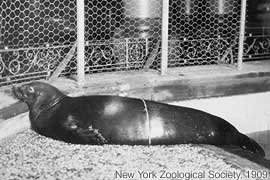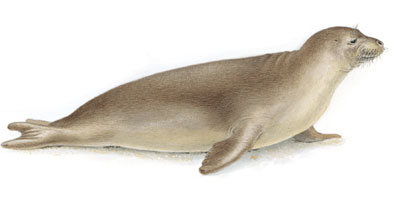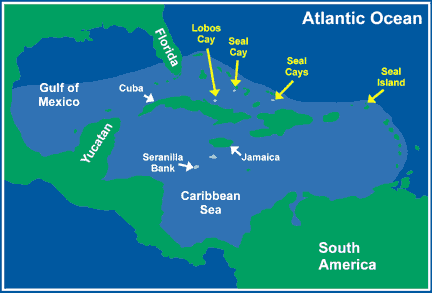
June 7, 2008
The news is sad.
Until 1995, there was no concerted effort to establish the status of the population of the Caribbean monk seal (Monachus tropicalis). While there had been only sporadic sightings, many were unconfirmed. Now, it appears, these pinnipeds exist no more.

The above image is the only known photograph of a Caribbean monk seal, taken at the Bronx Zoo in 1909. The species was formally declared extinct in 1996, according to some reports.
The history of the Caribbean monk seal and its relationship with humans remains unclear, though we have found some evidence to suggest that native tribes hunted it for its meat and hides. The species appears to have entered its fatal tailspin only after Europeans first journeyed to the New World.
Observing Caribbean ‘sea wolves’ on the coast of Santo Domingo in 1494, Columbus promptly ordered his crew to kill eight of the animals for food, paving the way for intensive exploitation of the species by settlers and traders who came in his wake. In 1707, the naturalist and physician Hans Sloane wrote that fishermen would catch 100 seals during a single night in the Bahamas, the animals’ blubber being melted down to produce lamp oil. Log-books from shipwrecked galleys also record that marooned sailors ate the seals. Some of the last surviving colonies were slaughtered for natural history museums.
During a single expedition to the Triangles off the Yucatan Peninsula in December 1886, for example, collectors killed 42 Caribbean monk seals, whose stuffed bodies and constituent parts were subsequently sold to some of the world’s most prestigious institutions. According to conventional wisdom, the last authentic record of a living Caribbean monk seal dates to 1952, when a small colony was observed on Serranella Bank, south-east of Jamaica. Source.

The Caribbean monk seal was formally declared extinct in the 1996 IUCN Red List of Threatened Animals. The last reported sighting in 1952 [drawing above is from 1952] was from Seranilla Bank between Jamaica and Honduras, where a small colony was known to have lived….In response to recent unconfirmed Caribbean monk seal sightings in areas within their historical range, surveys have been carried out as late as 1993. Source.

But were sightings in the Caribbean of the Caribbean monk seal or young hooded seals?
Despite the hopes of the sightings, the extinction of the Caribbean monk seal has been formally declared.
After five years of futile efforts to find or confirm sightings of any Caribbean monk seals — even just one — the U.S. government on Friday [June 6, 2008] announced that the species is officially extinct and the only seal to vanish due to human causes.
“Humans left the Caribbean monk seal population unsustainable after overhunting them,” Kyle Baker, a biologist for the National Marine Fisheries Service, said in a statement. “Unfortunately, this led to their demise and labels the species as the only seal to go extinct from human causes.”
A Caribbean monk seal — the only subtropical seal native to the Caribbean Sea and Gulf of Mexico — had not been seen for more than 50 years. The last confirmed sighting was in 1952 at Seranilla Bank, between Jamaica and the Yucatan Peninsula.
The United States listed the species as endangered in 1967. The fisheries service will now have the species removed from the list.
“Caribbean monk seals were first discovered during Columbus’s second voyage in 1494, when eight seals were killed for meat,” the fisheries service noted. “Following European colonization from the 1700s to 1900s, the seals were exploited intensively for their blubber, and to a lesser extent for food, scientific study and zoological collection. Blubber was processed into oil and used for lubrication, coating the bottom of boats, and as lamp and cooking oil. Seal skins were sought to make trunk linings, articles of clothing, straps and bags.”
Hawaiian, Mediterranean species at risk
Just two other monk seal species remain: Hawaiian and Mediterranean monk seals, both of which are endangered and at risk of extinction. Populations have fallen to below 1,200 and 500 individuals, respectively, the fisheries service stated.
“Worldwide, populations of the two remaining monk seal species are declining,” said Baker. “We hope we’ve learned from the extinction of Caribbean monk seals, and can provide stronger protection for their Hawaiian and Mediterranean relatives.”
The Hawaiian population is declining at a rate of about four percent per year, with challenges “such as lack of food sources for young seals, entanglement in marine debris, predation by sharks, and loss of haul-out and pupping beaches due to erosion,” the service said.
“The Hawaiian monk seal is a treasure to preserve for future generations,” said NMFS biologist Bud Antonelis. The “fisheries service has developed a monk seal recovery plan, but we need continued support from organizations and the public if we are to have a chance at saving it from extinction. Time is running out.”
“The fate of the Caribbean monk seal is a wake-up call for us to act quickly to protect other endangered monk seal populations. We must learn from our mistakes,” Vicki Cornish of Ocean Conservancy echoed in a separate statement. “We must act now to reduce threats to existing monk seal populations before it’s too late. These animals are important to the balance and health of the ocean — we can’t afford to wait.”
Other species of marine mammals that have gone extinct in modern times include the Atlantic gray whale (1700s or 1800s) and stellar sea cow (late 1700s), presumably due to overhunting by whalers, the fisheries service stated.
Climate connection
The Ocean Conservancy said some of the threats, especially erosion and debris, are tied to the El Nino weather pattern and rising sea levels, which in turn is tied to global warming.
“El Nino events, which cause storms similar to those expected to occur with increasing frequency as a result of climate change, drive marine debris closer to monk seal beaches and nearshore waters,” it added. “Seal pups play with trash, which can lead to entanglement and eventual death. Increased numbers of Hawaiian monk seals have been found entangled in marine debris after El Nino events.”
Entanglement happens even in “one of the best-protected ocean places in the United States,” the conservation group said, referring to the Northwestern Hawaiian Islands National Monument created by President Bush in 2006.
About Loren Coleman
Loren Coleman is one of the world’s leading cryptozoologists, some say “the” leading living cryptozoologist. Certainly, he is acknowledged as the current living American researcher and writer who has most popularized cryptozoology in the late 20th and early 21st centuries.
Starting his fieldwork and investigations in 1960, after traveling and trekking extensively in pursuit of cryptozoological mysteries, Coleman began writing to share his experiences in 1969. An honorary member of Ivan T. Sanderson’s Society for the Investigation of the Unexplained in the 1970s, Coleman has been bestowed with similar honorary memberships of the North Idaho College Cryptozoology Club in 1983, and in subsequent years, that of the British Columbia Scientific Cryptozoology Club, CryptoSafari International, and other international organizations. He was also a Life Member and Benefactor of the International Society of Cryptozoology (now-defunct).
Loren Coleman’s daily blog, as a member of the Cryptomundo Team, served as an ongoing avenue of communication for the ever-growing body of cryptozoo news from 2005 through 2013. He returned as an infrequent contributor beginning Halloween week of 2015.
Coleman is the founder in 2003, and current director of the International Cryptozoology Museum in Portland, Maine.
Filed under Breaking News, Cryptotourism, CryptoZoo News, Cryptozoologists, Cryptozoology, Extinct, Eyewitness Accounts